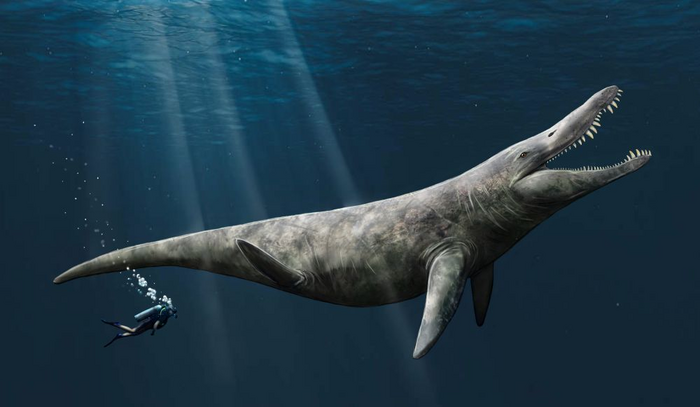
Liopleurodons that once swam the Jurassic seas were 80 feet long
Over two decades ago, the BBC’s Walking with Dinosaurs TV documentary series featured a massive 82-foot long Liopleurodon, sparking intense debate among paleontologists about the true size of this prehistoric marine reptile.
Experts believed that the size of the pliosaur had been significantly overestimated and that it likely only reached around six meters in length.
However, a recent accidental discovery in an Oxfordshire museum has breathed new life into the discussion, with paleontologists from the University of Portsmouth now suggesting that a similar species could have reached a staggering 47 feet, making it twice the size of a killer whale.
“I was a consultant for the BBC’s pilot program ‘Cruel Sea,’ and I hold my hands up – I got the size of Liopleurodon horrendously wrong,” admitted Professor David Martill from the University of Portsmouth’s School of the Environment, Geography and Geosciences.
How scientists calculated the size
He explained that his calculations were based on fragmentary material, which led to an overestimation of the pliosaur’s size and caused significant controversy at the time.
However, the recent discovery of four enormous vertebrae at Abingdon County Hall Museum has provided a more reliable basis for estimating the size of these fearsome marine reptiles.
Professor Martill and his co-author, Megan Jacobs, were at the museum when they stumbled upon the vertebrae, which are thought to belong to a Pliosaurus species or a closely related animal.
Similar to other sea monsters of the Jurassic
Pliosaurs were similar to plesiosaurs but had larger, elongated heads akin to crocodiles and shorter necks. These powerful swimmers had four flippers that acted as paddles and a relatively short tail.
After conducting topographic scans on the newly discovered vertebrae, Professor Martill and his colleagues estimated that the Late Jurassic marine reptile could have grown to a length of between 9.8 and 14.4 meters.
“We know these pliosaurs were very fearsome animals swimming in the seas that covered Oxfordshire 145-152 million years ago,” he said. “They had a massive skull with huge protruding teeth like daggers – as big, if not bigger than a T. rex, and certainly more powerful.”
These gigantic pliosaurs occupied the top of the marine food chain, likely preying on ichthyosaurs, long-necked plesiosaurs, and even smaller marine crocodiles. The evidence of their predatory behavior can be seen in the bite marks on ichthyosaur bones displayed in The Etches Collection in Dorset.
The vertebrae themselves were originally found during temporary excavations at Warren Farm in the River Thames Valley in Oxfordshire and come from the Kimmeridge Clay Formation, which dates back to the Late Jurassic period, around 152 million years ago.
“It’s wonderful to prove there was indeed a truly gigantic pliosaur species in the Late Jurassic seas,” said Professor Martill. “Although not yet on a par with the claims made for Liopleurodon in the iconic BBC TV series Walking With Dinosaurs, it wouldn’t surprise me if one day we find some clear evidence that this monstrous species was even bigger.” With this new discovery, the debate over the true size of these colossal marine reptiles is far from over, and the search for even larger specimens continues.
More about pliosaurs
Pliosaurs were a group of large, predatory marine reptiles that lived during the Mesozoic Era, specifically from the Late Triassic to the Late Cretaceous period, approximately 215 to 80 million years ago. They belonged to the order Plesiosauria and were characterized by their large size, powerful bodies, and distinct features that set them apart from other plesiosaurs.
Here’s what we know about pliosaurs:
Physical characteristics
Pliosaurs had a large, elongated head with massive jaws filled with sharp, conical teeth. Their skull was more similar to that of a crocodile than to other plesiosaurs. They had a short neck, which was a distinguishing feature from their long-necked plesiosaur relatives.
Pliosaurs had a stout, streamlined body with four powerful, paddle-like flippers and a relatively short tail. They could grow to lengths of up to 15 meters (49 feet) or more, with some species like Kronosaurus and Pliosaurus being among the largest known.
Habitat and distribution
Pliosaurs were marine reptiles that lived in oceans around the world, with their fossils being found in Europe, North America, South America, Africa, and Australia. They thrived in warm, shallow seas that covered large parts of the Earth during the Mesozoic Era.
Diet and hunting behavior
As apex predators, pliosaurs fed on a variety of marine animals, such as fish, squid, and other marine reptiles like ichthyosaurs, plesiosaurs, and even smaller marine crocodiles. Their powerful jaws and sharp teeth allowed them to crush bones and tear through flesh with ease. They likely relied on ambush tactics, using their speed and strength to attack unsuspecting prey.
Locomotion
Pliosaurs were strong swimmers, using their four paddle-like flippers for propulsion. They could maneuver through the water with surprising agility for their size, making them highly effective predators.
Reproduction
Pliosaurs, like other marine reptiles, are believed to have given birth to live young in the water, rather than laying eggs on land like many modern reptiles. This is supported by the discovery of pregnant marine reptiles, including plesiosaurs and ichthyosaurs, with well-developed embryos preserved inside their bodies.
Extinction
Pliosaurs went extinct during the Late Cretaceous period, about 80 million years ago. The exact cause of their extinction is not clear, but it may have been due to a combination of factors, such as changing sea levels, competition from other marine predators like mosasaurs, or a decline in prey species.
Fossil discoveries
Pliosaur fossils have been found all over the world, with some of the most notable discoveries including species like Liopleurodon, Kronosaurus, and Pliosaurus. These fossils have provided valuable insights into the anatomy, ecology, and behavior of these fascinating marine reptiles.
Image Credit: Megan Jacobs, University of Portsmouth
—-
Check us out on EarthSnap, a free app brought to you by Eric Ralls and Earth.com.












